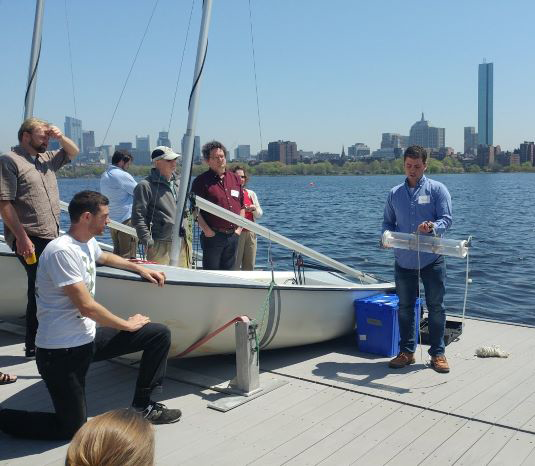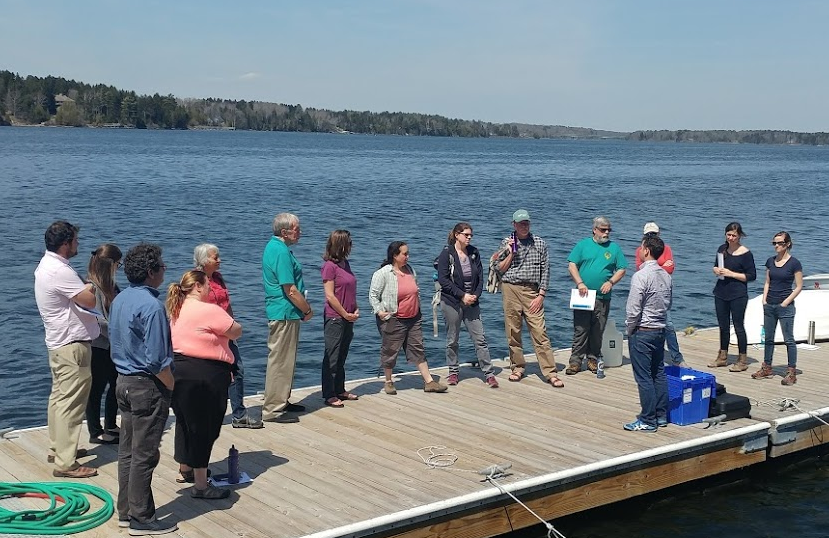A Strategy for Ocean and Coastal Acidification (OCA) Education and Citizen Science Monitoring in the Northeast
In the spring of 2018 NECAN held a series of webinars and workshops for community and citizen science monitoring programs to consider approaches for monitoring OCA influenced by freshwater input and eutrophication processes. Because of the dynamic range of nearshore carbon system conditions, coastal acidification has traditionally been difficult to monitor. However, local and coast-wide monitoring is critically necessary to understand;
- How conditions vary with season and precipitation events in each locality
- How coastal acidification relates to other water quality questions
- If there are areas already prone to acidification and presently in need of environmental protections or restoration efforts
Initial webinars provided perspective on the value of OCA monitoring, commonly measured parameters, how to align OCA research hypotheses/monitoring with existing monitoring efforts, as well as data sharing, research coordination, and the recently approved EPA Guidelines for OCA monitoring.
Summary of Workshops
 In May, three in-person workshops were held in Connecticut, Maine, and Massachusetts. Comparing distinct coastal systems and focusing on case studies can be enormously informative. The publication of EPA guidelines for monitoring coastal acidification in the Northeast is a helpful step for researchers to use suitable and comparable methodologies when measuring pH, Total Alkalinity (TA), the partial pressure of CO2 (pCO2), and Dissolved Inorganic Carbon (DIC). Authors of the EPA guidelines joined the workshops and provided demonstrations of field and lab monitoring equipment.
In May, three in-person workshops were held in Connecticut, Maine, and Massachusetts. Comparing distinct coastal systems and focusing on case studies can be enormously informative. The publication of EPA guidelines for monitoring coastal acidification in the Northeast is a helpful step for researchers to use suitable and comparable methodologies when measuring pH, Total Alkalinity (TA), the partial pressure of CO2 (pCO2), and Dissolved Inorganic Carbon (DIC). Authors of the EPA guidelines joined the workshops and provided demonstrations of field and lab monitoring equipment.
At each workshop, local science advisors provided information from their research programs and gave examples of the types of instruments they use for measurements. Participants discussed the differences between 'climate-quality' data that can constrain open ocean acidification conditions and track global long-term trends vs. 'weather-quality' data that may not be at the same level of precision, but more accurately reflects variable conditions and shorter-term trends in coastal areas. We also introduced ways of sharing data and the new Ocean Acidification Information Exchange as a forum for fostering communication and collaboration.
During round table discussions, local monitoring sites were mapped and existing relationships were recognized among monitoring groups. It will be important to continue communication and coordination among water monitoring organizations, and among research and government programs in order to understand both short term and long term conditions of coastal acidification across the Northeast region.
Outcomes and Conclusions
 The people and organizations joining the workshops were eager to know how their measurements can help to tell the story of coastal acidification. Some community monitoring groups in Connecticut, Maine, and Massachusetts are ready now to expand current monitoring practices to include two of the four carbon system parameters, which, alongside temperature and salinity can fully determine the saturation state of calcium carbonate (omega). This will be valuable for understanding vulnerable conditions for shellfish and other organisms, and for applying observations from monitoring for decision making and local management actions when or if needed.
The people and organizations joining the workshops were eager to know how their measurements can help to tell the story of coastal acidification. Some community monitoring groups in Connecticut, Maine, and Massachusetts are ready now to expand current monitoring practices to include two of the four carbon system parameters, which, alongside temperature and salinity can fully determine the saturation state of calcium carbonate (omega). This will be valuable for understanding vulnerable conditions for shellfish and other organisms, and for applying observations from monitoring for decision making and local management actions when or if needed.
Groups recognized that the most practical step to assess omega saturation state would be to measure pH with hand-held sensors and to incorporate total alkalinity measurements using bottle sampling. Certified laboratories able to run TA samples exist in each region, and developing partnerships with these laboratories is a priority for many groups in the near future. Funding to run samples is a challenge that may be overcome through partnership efforts or fundraising as a network.
It was emphasized that measuring even a single carbon system parameter, often pH, is helpful to constrain the range of nearshore conditions of acidification. This is especially helpful when pH is paired with nutrient and dissolved oxygen data. Though independent pH measurements that are already valuable now may become even more informative in the future, as some research groups are developing proxies for co-varying parameters (for example TA and salinity) that could hindcast saturation state values from previously collected data.
 An innovative approach emerged for sampling 'blitz' events to measure a suite of parameters at a large geographic range 4 times per year. Such episodic but comprehensive sampling practices could help illustrate relationships between salinity and TA among seasonal patterns of coastal acidification. Coast wide sampling could also help indicate areas of relative vulnerability and resilience of OCA that may inform strategic and sustained efforts over time. Science advisors among the workshop regions (CT, ME, and MA) expressed interest in participating in such an effort. NECAN expressed an interest in helping to support this type of collective effort for the summer of 2019, and if possible, for the fall of 2018.
An innovative approach emerged for sampling 'blitz' events to measure a suite of parameters at a large geographic range 4 times per year. Such episodic but comprehensive sampling practices could help illustrate relationships between salinity and TA among seasonal patterns of coastal acidification. Coast wide sampling could also help indicate areas of relative vulnerability and resilience of OCA that may inform strategic and sustained efforts over time. Science advisors among the workshop regions (CT, ME, and MA) expressed interest in participating in such an effort. NECAN expressed an interest in helping to support this type of collective effort for the summer of 2019, and if possible, for the fall of 2018.
Concluding discussions and strategy focused on the opportunity to expand communication among agencies and monitoring organizations to prioritize understanding relative drivers of coastal acidification, and to assess the relative vulnerability to acidification among localities rather than pursuing observations of decadal change and climate-quality data.
Next Steps
- Surveys have been sent out to participants and responses are being compiled.
- Gauge interest in a sampling 'blitz' events for TA and salinity relationships and relative OCA vulnerability.
- Assess how many sampling sites per monitoring organization may be needed to adequately overview sampling areas during 'blitz' events.
- Assess how citizen science and community science data can most effectively link with ongoing regional research and agency monitoring, (e.g. an early warning system where low pH or omega readings can alert further state involvement.
- Facilitate further collaboration between community science program staff and agency staff.
- Pursue fundraising or grant opportunities for the cost of TA bottle sample analyses.
- Pursue easy to use data sharing options that can be implemented regionally:
- Build upon workshop mapping exercise to establish online mapping platform, potentially ARC GIS Online Story Map.
- The Anecdata program from Mount Desert Island Biological Laboratory is a possible data platform option that was highlighted during the workshops. Anecdata could be used in the relatively near future to safeguard monitoring data from the insecurity of individual excel files and paper storage. Data portals, including Anecdata, can be made publically available to support collaborative use and data sharing among monitoring organizations, state organizations, and regional data centers (e.g. The Northeastern Regional Association of Coastal Ocean Observing Systems, NERACOOS).
- Our project team is now in the early stages of supporting this goal by initiating mapping with GIS and will be reaching out to the Anecdata team to discuss developing a specific coastal acidification data/metadata platform or comprehensive water quality platform through anecdata.
- The citizen science training workshops also created a direct synergy with an additional OAP funded regional data synthesis (DS) project on which several mini-grant Principal Investigators (PIs) participate. During the workshop in Maine on May 2, 2018, several citizen science groups that have been collecting calibrated nearshore pH measurements in Maine for the last several years but who had not previously connected with researchers, were able to provide access to their datasets, metadata, and detailed information in support of the OAP funded regional data synthesis project. The direct, in-person, connection with these stakeholder scientists facilitated smooth incorporation of their data into the data synthesis. Spatially, the areas covered by these groups had not previously been included in our DS project. The groups include Boothbay Harbor Land Trust and Marine and Environmental Research Institute.
Printed Materials
- Carbon Species Scale Graphic
- Coastal Acidification Graphic
- EPA Monitoring Guidelines
- NECAN Ocean and Coastal Acidification Overview
- New England Interstate Water Pollution Control Commission
- Twenty Facts about Ocean Acidification
- OCA Chemistry Processes
- National Research Council of the National Academies: Ocean Acidification; Starting with Science
- Predicted Global Aragonite Saturation State
- Information to Action: Strengthening EPA Citizen Science Partnerships for Environmental Protection
Resources
Websites
- Ocean Acidification Information Exchange (OAIE)
- Northeastern Regional Association of Coastal Ocean Observing Systems (NERACOOS)
- NOAA Ocean Acidification Program (OAP)
Literature
- NECAN Reference Library
- OAIE Documents
- Maine OCA Commission Report
- Northeast Regional Ocean Council (NROC) and NECAN OCA Monitoring Workshop Report
- Information to Action: Strengthening EPA Citizen Science Partnerships for Environmental Protection
- EPA Guidelines for Measuring Changes in Seawater pH and Associated Carbonate Chemistry in Coastal Environments of the Eastern United States
Webinars and Videos
Northeastern Regional Association of Coastal Ocean Observing Systems (NERACOOS)
National Oceanic and Atmospheric Administration (NOAA)








